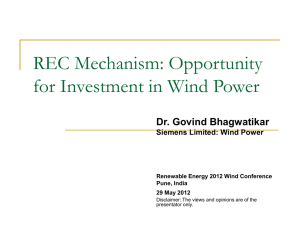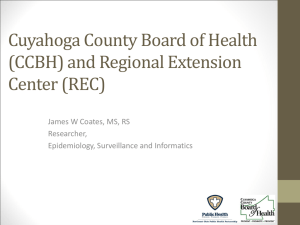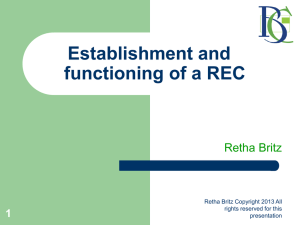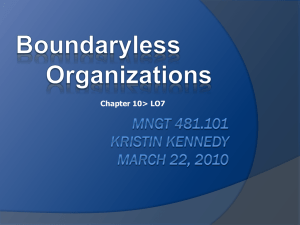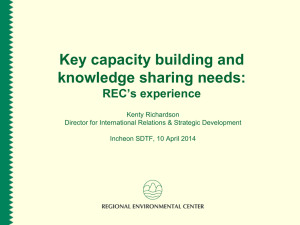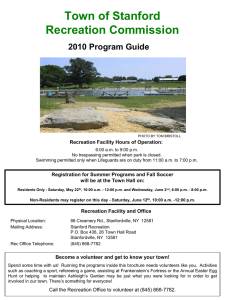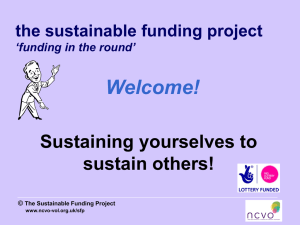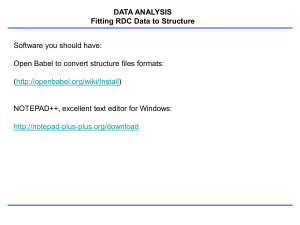Visualizing and annotating rule
advertisement
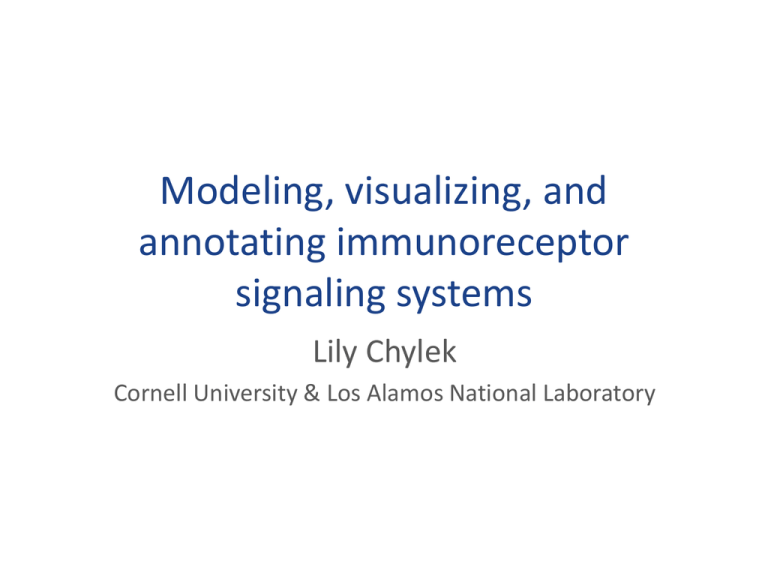
Modeling, visualizing, and annotating immunoreceptor signaling systems Lily Chylek Cornell University & Los Alamos National Laboratory Outline • Methods for model visualization • Extended contact map and model guide • Applications: large-scale models of immunoreceptor signaling Signaling proteins • Multiple components mediate interactions with other proteins. • Interactions regulated by post-translational modifications at multiple sites. • Combinatorial complexity: many possible binding and modification states. ZAP-70 Features of early events in immunoreceptor signaling • Multi-subunit receptors (e.g., FcεRI, TCR) interact with ligands • Phosphorylation of tyrosine residues in ITAM motifs • Binding of SH2 domains to receptor • Regulation of kinases by phosphorylation of specific residues Rule-based modeling offers a viable approach to modeling these (and other) cell signaling systems. Rule-based modeling Prospects: • A great deal of information is available about a number of signal transduction systems. • This information can be used to specify rules. • Algorithms and software tools are available that allow us to simulate large-scale rule-based models. Challenges: • How can we communicate the content of a large model? • Can we associate each rule with its biological basis? Rule-based modeling Rec(a) + Lig(l,l) <-> Rec(a!1).Lig(l!1,l) kp1, km1Rec(a) + Lig(l,l!1) <-> Rec(a!2).Lig(l!2,l!1) kp2,km2 Rec(b∼Y) + Lyn(U,SH2) <-> Rec(b∼Y!1).Lyn(U!1,SH2) kpL, kmL Lig(l!1,l!2).Lyn(U!3,SH2).Rec(a!2,b Y!3).Rec(a!1,b∼Y) -> Lig(l!1,l!2).Lyn(U!3,SH2).Rec(a!2,b Y!3).Rec(a!1,b∼pY) pLb Lig(l!1,l!2).Lyn(U,SH2!3).Rec(a!2,b pY!3).Rec(a!1,b∼Y) -> Lig(l!1,l!2).Lyn(U,SH2!3).Rec(a!2,b pY!3).Rec(a!1,b∼pY) pLbs Lig(l!1,l!2).Lyn(U!3,SH2).Rec(a!2,b Y!3).Rec(a!1,g∼Y) -> Lig(l!1,l!2).Lyn(U!3,SH2).Rec(a!2,b Y!3).Rec(a!1,g∼pY) pLg Lig(l!1,l!2).Lyn(U,SH2!3).Rec(a!2,b pY!3).Rec(a!1,g∼Y) -> Lig(l!1,l!2).Lyn(U,SH2!3).Rec(a!2,b pY!3).Rec(a!1,g∼pY) pLgs Rec(b∼pY) + Lyn(U,SH2) <-> Rec(b∼pY!1).Lyn(U,SH2!1) kpLs, kmLsRec(g∼pY) + Syk(tSH2) <-> Rec(g∼pY!1).Syk(tSH2!1) kpS, kmS Lig(l!1,l!2).Lyn(U!3,SH2).Rec(a!2,b∼Y!3).Rec(a!1,g pY!4).Syk(tSH2!4,l∼Y) -> Lig(l!1,l!2).Lyn(U!3,SH2).Rec(a!2,b∼Y!3).Rec(a!1,g pY!4).Syk(tSH2!4,l∼pY) pLS Prospects: • A great deal of information is available about a number of signal transduction systems. • This information can be used to specify rules. • Algorithms and software tools are available that allow us to simulate large-scale rule-based models. Challenges: • How can we communicate the content of a large model? • Can we associate each rule with its biological basis? Method 1: Individual rules How are components transformed by a rule? Advantage • Rules are easily visualized. Problem • Locally comprehensible, globally incomprehensible. Method 2: Contact map How do molecules bind? Advantages • All molecules, components, states, and binding interactions are presented. • Can be generated automatically (GetBonNie, RuleBender, Rulebase/Kappa). Problems • Lacks clear representation of enzyme-substrate relationships. • Does not always show accurate substructure. Method 3: Molecular interaction map How do molecules interact, and how do interactions affect each other? Advantage • Catalytic interactions are distinguishable from binding interactions. • Each molecule is shown only once. Problem • Too much information (context). Maps become cluttered for complex networks. What do we need from a diagram? • A comprehensive representation of molecules and interactions in a model. • Understandable, not overloaded with information. • Connections to rules and biological knowledge. Outline • Methods for model visualization • Extended contact map and model guide • Applications: large-scale models of immunoreceptor signaling Extended contact map What is the big picture of molecules and interactions in a model? Extended contact map • Multiple levels of nesting to show protein substructure. Extended contact map • Multiple levels of nesting to show protein substructure. • Distinguish different types of interactions (binding vs. catalysis). Extended contact map • Multiple levels of nesting to show protein substructure. • Distinguish different types of interactions (binding vs. catalysis). Extended contact map • Multiple levels of nesting to show protein substructure. • Distinguish different types of interactions (binding vs. catalysis). • Show sites of posttranslational modification. Extended contact map • Use tags to show locations of molecules. Extended contact map • Use tags to show locations of molecules. • Use shading to indicate hierarchy of molecules in signaling. Extended contact map • Use tags to show locations of molecules. • Use shading to indicate hierarchy of molecules in signaling. • Connect interactions to rules, where context is accounted for. Extended contact map • Use tags to show locations of molecules. • Use shading to indicate hierarchy of molecules in signaling. • Connect interaction to rule(s), where context is accounted for. Annotation: Model guide 8 8 Can we model and visualize other common processes in cell signaling? Ubiquitination cascade • E1 catalyzes transfer of ubiquitin from itself to E2. • E3 catalyzes transfer of ubiquitin from E2 to target protein. HRas • HRas is a GTPase. HRas • HRas is a GTPase, stimulated by RasGAP. HRas • HRas is a GTPase, stimulated by RasGAP. • Nucleotide exchange stimulated by Sos1. HRas • HRas is a GTPase, stimulated by RasGAP. • Nucleotide exchange stimulated by Sos1. • Sos1 allosterically activated by binding HRas. HRas • HRas is a GTPase, stimulated by RasGAP. • Nucleotide exchange stimulated by Sos1. • Sos1 allosterically activated by binding HRas. • Raf-1 binds GTPbound HRas. Outline • Methods for model visualization • Extended contact map and model guide • Applications: large-scale models of immunoreceptor signaling Conclusions • As we formulate larger models, it will be necessary to have a consistent means of model visualization and annotation. • An extended contact map and model guide annotate a signal-transduction system in a form that is both visual and executable. http://bionetgen.org/index.php/Extended_Contact_Maps Thanks! Bill Hlavacek Bin Hu Michael Blinov Thierry Emonet Jim Faeder Byron Goldstein Ryan Gutenkunst Jason Haugh Tomasz Lipniacki Richard Posner Jin Yang
